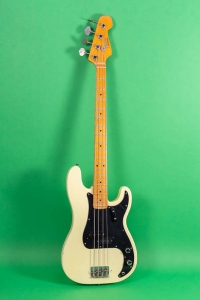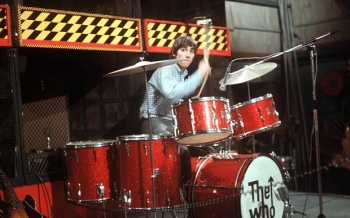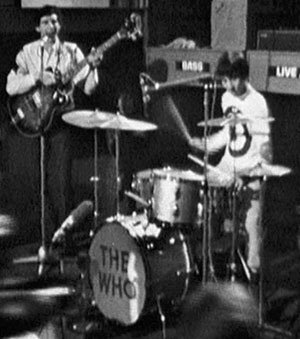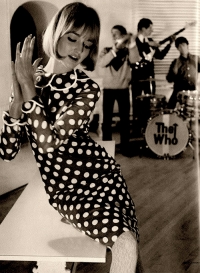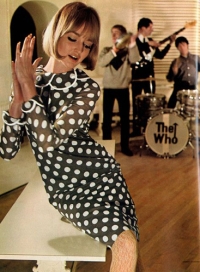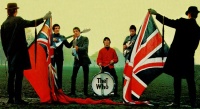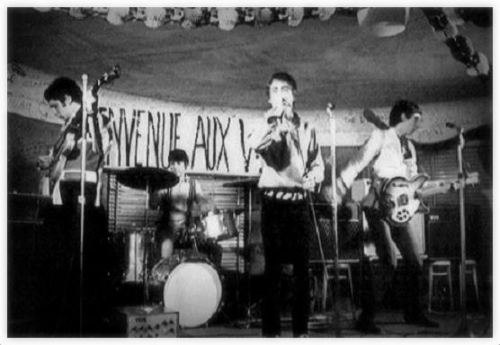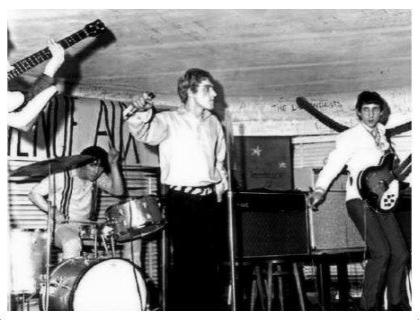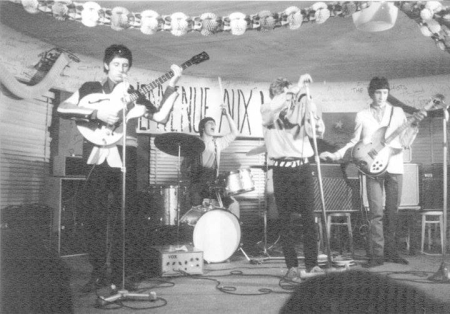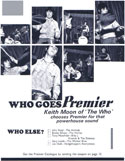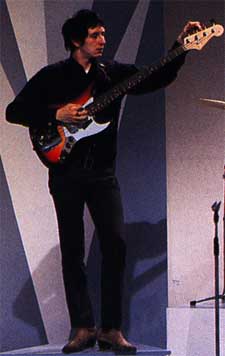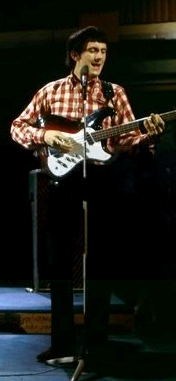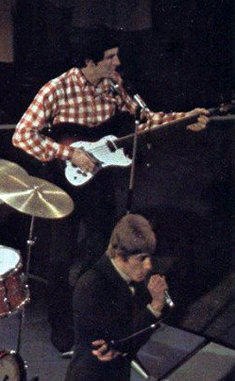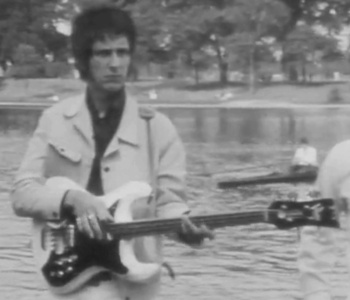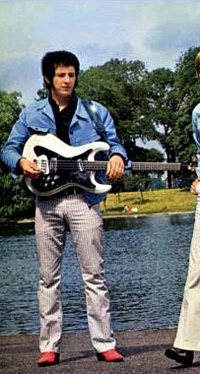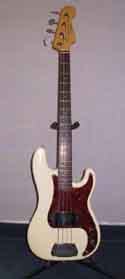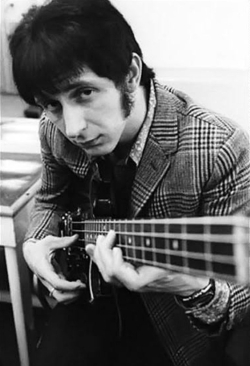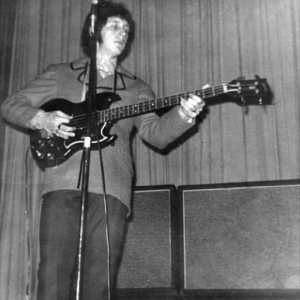John Entwistle’s Gear: 1964–1966
Fender P’s and J’s etc.; Marshall, Vox, Marshall
Sale news (September 2022): A reported Entwistle Fender Precision slab bass was listed for sale on Reverb.
Whotabs has not verified provenance on this item, and is merely posting what is listed in Reverb.
Source: Reverb posting
Fender Precision Bass Rare Slab Body John Entwistle 1966 White
Jay Rosen Music, Emeryville, CA, United States
$46,500
Precision Bass Rare Slab Body John Entwistle
Finish: White
Year: 1966This is a very rare and obscure model Fender bass of which books have been written about. This is not a book. Fender made scant few of this bass... around 25... which were sent to and sold only in the UK. This one is from the John Entwistle collection and was purchased at the auction of his instruments and other items years ago with full documentation. According to John in his book “Bass Culture” he purchased this one in the 1970s and the body is refinished. This model is often associated with Entwistle and he has been quoted saying that these have a very special unique tone. The neck is a maple cap... maple fingerboard which is rare in 1966 but was the normal feature for this export model. Further reading is available elsewhere, the bass is available here.
See Reverb
Bass guitars – 1964–1966
-
Epiphone Rivoli EBV232 semi-acoustic bass (sunburst)
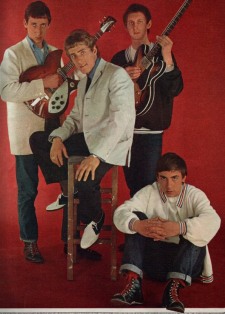
Click to view larger version. Ca. September 1964, as the High Numbers, John with sunburst Epiphone Rivoli semi-acoustic bass.
John’s second proper bass was an Epiphone Rivoli EBV232 semi-acoustic bass with a Gibson-style pickguard.
Bass Culture:
“Fads change and I partly exchanged [the Fender Precision bass] for £50.00 at Marshall’s Music Store for a sunburst Semi-Acoustic Epiphone Rivolvi [sic], which I later partly exchanged for a Rickenbacker.”
The Epiphone Rivoli featured a semi-hollow body, a short scale (30.5″) neck and one large “Sidewinder” humbucker pickup in the neck position.
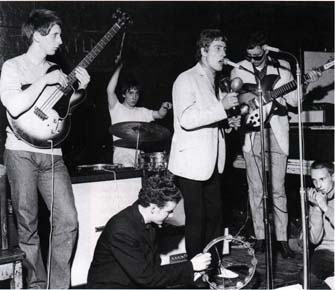
22 July 1964, as the High Numbers at the Scene Club, John with early Marshall 4×12 and sunburst Epiphone Rivoli semi-acoustic bass.
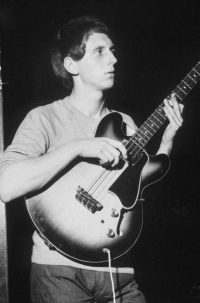
22 July 1964, as the High Numbers at the Scene Club, John with sunburst Epiphone Rivoli semi-acoustic bass.
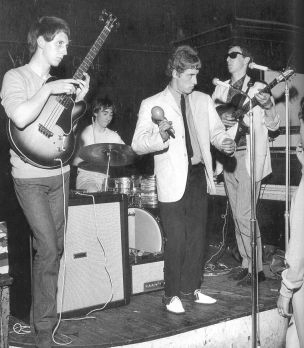
22 July 1964, as the High Numbers at the Scene Club, John with early Marshall 4×12 and sunburst Epiphone Rivoli semi-acoustic bass.
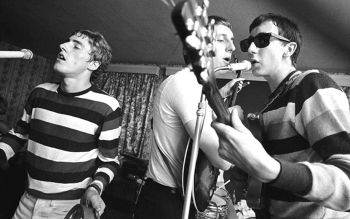
Click to view larger version. Ca. August/September 1964, at the Railway Hotel, with Epiphone Rivoli bass, and what appears to be a Marshall amplifier in the backline.
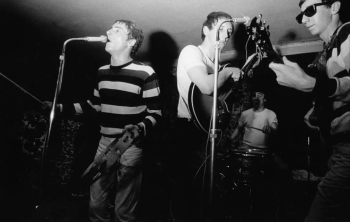
Click to view larger version. Ca. August/September 1964, at the Railway Hotel, with Epiphone Rivoli bass.
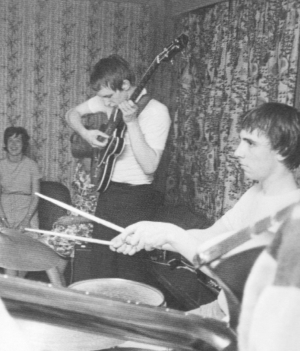
Ca. August/September 1964, at the Railway Hotel, with Epiphone Rivoli bass.
-
Rickenbacker Rose, Morris, Co. LTD, 1964 Model 1999 (4001S) Bass
Rose, Morris, Co., LTD, export version of the Rickenbacker 4001S bass, with unbound Fireglo body, dot neck, thru-body one-piece construction, magnetic horseshoe bridge pickup, mono ouput, ½″ diameter tuning pegs with “Elephant ear” tuning machines.
Acquired in exchange for the Epiphone Rivoli.
Bass Culture:
“After eleven months use, the Rickenbacker developed a neck so bowed you could fire an arrow from it. So, off it went in part exchange for a Gretsch.”
From the October 1974 Guitarist:
- You had a Rickenbacker, didn’t you?
-
Yes, Townshend used Rickenbacker guitars and I had a Rickenbacker bass. That was around 1963–64. But the neck went on that one.
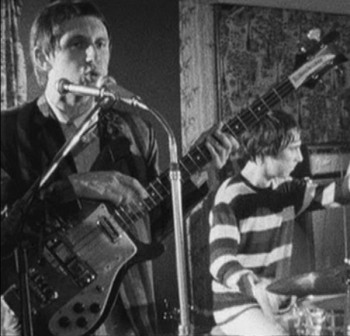
Ca. August/September 1964, at the Railway Hotel, with Rickenbacker Rose, Morris, Co. LTD, 1999 (4001S) bass. Photo courtesy Jake Kety
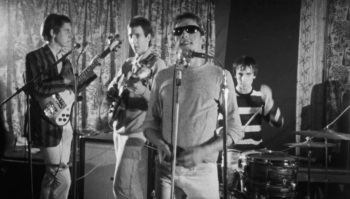
Click to view larger version. Ca. August/September 1964, at the Railway Hotel, with with Rickenbacker Rose, Morris, Co. LTD, 1999 (4001S) bass and early Marshall 4×12 speaker cabinet.
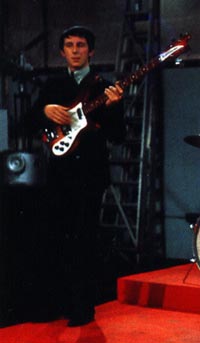
29 Jan. 1965, on Ready Steady Go!, with Rickenbacker Rose, Morris, Co. LTD., 1999 (4001S) bass in FireGlo.
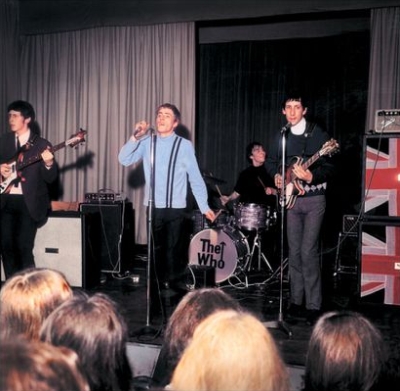
Ca. March 1965, Rickenbacker Rose, Morris, Co. LTD., 1999 (4001S) bass in FireGlo, with Marshall 4×12 cabinets. A precursor to the actual “Marshall” stack, Pete stacks a blonde ’64 Fender Bassman head on two Marshall 4×12 cabinets with British flag “grillecloths.”
-
Gretsch 6070 Hollow Body (“Country Gentleman”) Bass
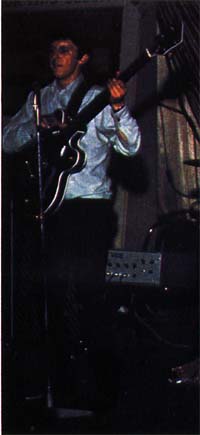
Ca. 1965, John playing a Gretsch 6070 Hollow Body bass.
Acquired in exchange for the Rickenbacker bass.
Bass Culture:
“The neck on the Gretsch was so thick it couldn’t possibly bow, at the same time it couldn’t possibly be played either! My hands would become tired after ten minutes, so I bought a Danelectro Longhorn to give my hands a rest. I used both bassses for a while but eventually favored the Danelectro.”
From the October 1974 Guitarist:
“Then I bought a Gretsch bass with a neck like a tree trunk and I found I got rather tired playing it.”
- 17″ double cutaway 2″ thick bound hollow body
- Single Filter’Tron or Super’Tron bass pickup
- Upper-bout three-position tone switch, lower-bout mute switch
- Adjustable four-string Space Control bridge and “G” cutout tailpiece
- 24-carat gold-plated metal parts
- Bound ‘F’-holes
- Built-in string mute/muffler
- Padded back
- Shaded sunburst finish
-
Vox (Mark IV?) Teardrop bass
Vox (Mark IV?) Teardrop (black with pearloid scratchplate) bass guitar appearing in promotional photo shoots, one of which appeared in the March 1965 Seventeen magazine.
-
Gibson EB-2 semi-acoustic bass (natural)
Used approximately May to June 1965, including 23 May 1965 television appearance Thank Your Lucky Stars, and The Who–s first gig outside of the United Kingdom at the Club au Golf Drouot in Paris on 2 June, 1965.
-
Danelectro Long Horn model 4423 bass
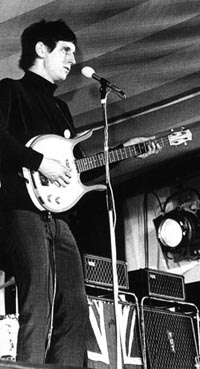
6 Aug. 1965, Richmond, for the 5th National Jazz & Blues Festival, Danelectro Long Horn model 4423 bass, with twin lipstick-style pickups and rosewood fretboard.
John owned three of these basses, and used them on the initial recording sessions for My Generation. All three sold to buy the Fender Jazz bass.
Bass Culture:
“I bought a Danelectro Longhorn to give my hands a rest [from the Gretsch]. I used both bassses for a while but eventually favored the Danelectro.”
- Bronze sunburst, two lipstick tube Alnico pickups with two concentric knobs; bolt-on necks with Brazilian rosewood fingerboards, masonite/poplar frame bodies; 24 frets, “Coke Bottle” peghead.
- On the recording of My Generation:
“I bought this Danelectro bass and it had these tiny, thin wirewound strings on. They were so thin, they sounded just like a piano, an unbelievably clear sound. The only thing was that you couldn’t buy these strings. When we recorded ‘My Generation,’ I ended up with three of these Danelectros just for the strings. The last one I had, the string busted before we actually got into the studio to re-record it, so I did it on a Fender Jazz in the end with tape-wound La Bella strings.”
“I played that solo on a Jazz bass with tapewound strings through a Marshall 50 watt and 4×12. Interestingly, the bass solos on the earlier takes were much more complicated, and played on a Danelectro which had a much more piano-like sound. It was a medium scale bass with a two-octave neck. The trouble was that the strings were so thin that I kept breaking them. We’d record during the day and, to finance the sessions, we were playing gigs nearly every night, and inevitably I’d break a string. None of the music shops had any replacement strings and no string manufacturers made replacement strings thin enough for Dano basses then, so I had to go down to Marshall’s and buy a new Dano for £60. I ended up with three new Danelectros, all with busted strings! In the end I busted my last string at the third attempt and there weren’t any more in the country. I thought, ‘Fuck it’, and went and bought myself a Fender Jazz bass and a set of La Bella strings, and played the solo with that. But it was a different sound and a simplified, slowed-down version of the solos on previous takes.”
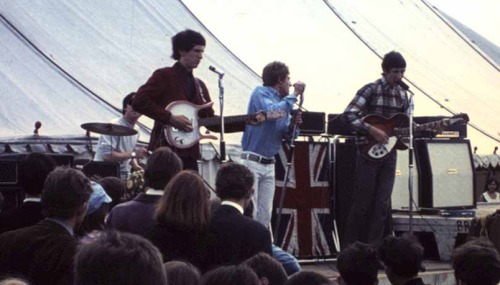
19 June 1965, at the Uxbridge Blues and Folk Festival, with Danelectro Long Horn model 4423 bass and Vox T.60 cabinets topped with Vox AC-100 amplifier heads. Courtesy SoundCityChris.
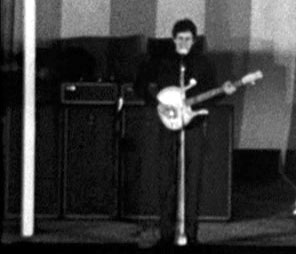
6 Aug. 1965, Richmond for the 5th National Jazz & Blues Festival, front view of Danelectro Long Horn model 4423 bass, and Vox T.60 cabinets topped with Vox AC-100 amplifier heads.
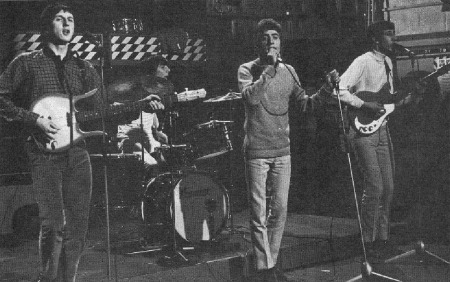
6 Aug. 1965, The Who appeared on Ready Steady Go! at Wembley Studios in London using borrowed gear as their regular gear was already in Richmond for the 5th National Jazz & Blues Festival gig that night. Pete is seen with a Danelectro Standard Shorthorn. And both Pete and John are using Vox AC-30 combos.
-
1965 sunburst Fender Jazz Bass
- Bought in October 1965 for the recording of My Generation
- Serial no. L89716
-
John:
“I used this on ‘My Generation’ and a lot of other stuff until I changed over to Precision basses.”
Bass Culture:
“I decided that enough was enough and sold all three Danelectros and the Gretsch to buy a sunburst Jazz bass. The final version of ‘My Generation’ was played on the Jazz with La Bella tape wound strings.
“I’d finally come to my senses. I had been losing basses and money hand over fist so I made the decision — no more selling! I continued playing the Jazz bass on stage and on records.”
- Featured on p. 42 of Bass Culture
- Collection of David Swartz
- On display through October 2019 at the Play It Loud Exhibition at the Metropolitan Museum of Art in New York.
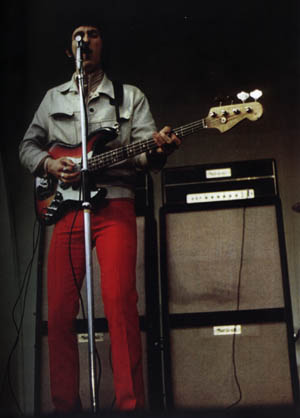
On stage, 2 June 1966, Grona Lund, Sweden, with 1965 Fender Jazz Bass.
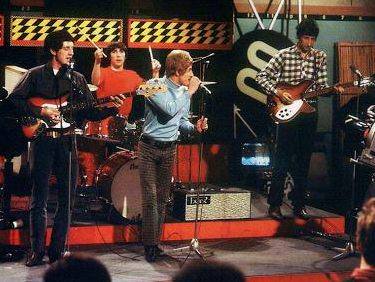
Ca. November 1965, for television appearance on Ready Steady Go!.
-
1963(?) Fender Bass VI
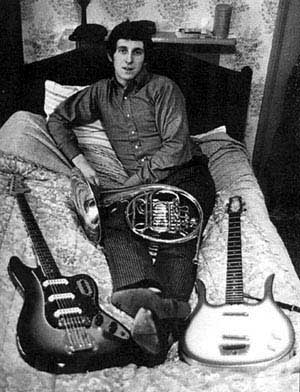
Ca. 1966, with 1963(?) Fender Bass VI and Danelectro Long Horn bass.
The Fender Bass VI was a six-string bass, tuned EADGBE but an octave lower than a guitar, with a 30″-scale bolt-on C-shaped maple neck with rosewood fretboard, three single-coil pickups, alder body, with vintage-style floating tremolo with tremolo lock button.
-
From April 1995 Bassist interview
“Around 1964 or 65, I had a Fender Bass VI for about six months but I could never get enough bottom end out of the f***ing thing. Nowadays you could probably get a really good sound out of it because of the control you get from modern amplifiers, but playing through a Marshall or Hiwatt, as I was, there was only a certain amount of bottom end available.”
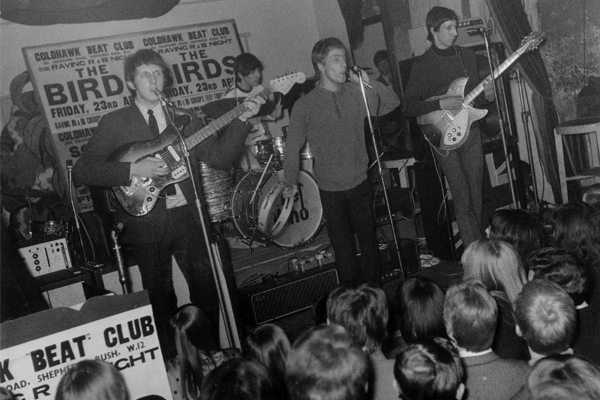
16 April 1965, at the Goldhawk, playing (1963?) Fender Bass VI. Two Marshall 4×12 visible in backline.
-
-
1965 Mosrite Ventures bass
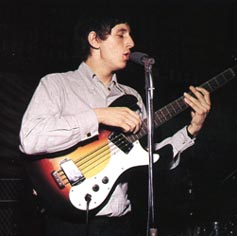
Ca. 1965, Mosrite Ventures bass in sunburst.
- Sunburst, single-pickup version
- Used on stage (unknown time period)
- Sold in 1966, according to Bass Culture.
- Also a white Mosrite Ventures two-pickup version
- As seen in promo video for The Kids Are Alright.
- Reportedly used on The Who Sell Out studio sessions.
- Sunburst, single-pickup version
-
1962 Fender Precision Bass
Bass Culture:
“A string of Precisions followed [the Mosrite and Fender VI] and eventually the Precisions became my main stage basses for the next six years.”
- Originally sunburst in color, John had it refinished white sometime around February 1966. This bass is distinctive in that it has the Rosewood fretboard and the tortoise shell pick guard.
- Serial no. 80965.
- Was owned by Who collector Brad Rodgers, sold via auction for £13,750 at Christie’s Popular Culture: Rock and Pop Memorabilia sale, on 24 June 2010.
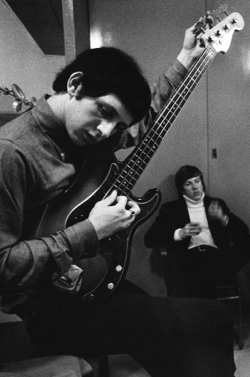
8 Jan. 1966, Jigsaw Club, Manchester, backstage tuning up the unrefinished 1962 Fender Precision bass.
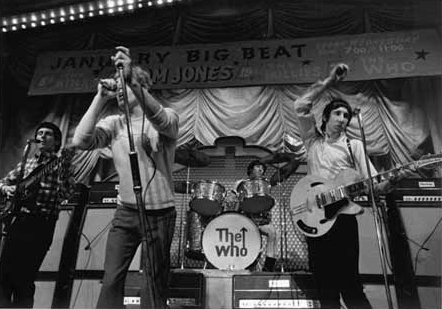
26 Jan. 1966, Locarno Ballroom, Stevenage, John’s bass appears to be the unrefinished 1962 Fender Precision bass. John and Pete both playing through two Marshall JTM45 100 (prototype 1959 JTM100 Super Lead; Pete using JTM45 100 Tremolo) 100-watt amplifiers, connected by Y-cable, and driving two Marshall 8×12 cabinets.
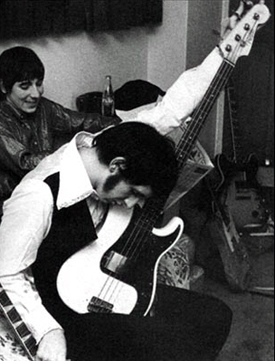
29 Jan. 1967, with the refinished 1962 Fender Precision bass.
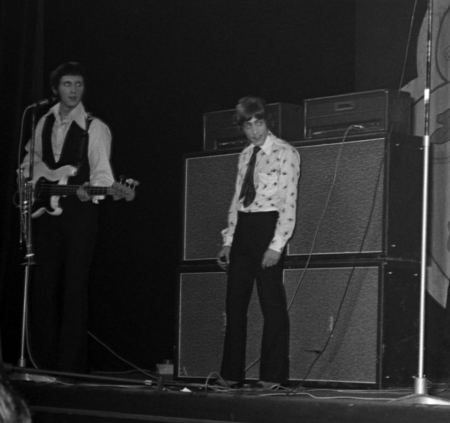
29 Jan. 1967, with the refinished 1962 Fender Precision bass.

News (28 April 2010): Christie’s to auction 1962 Fender Precision bass, as part of its Popular Culture: Rock and Pop Memorabilia sale, to be held on 24 June 2010. The instrument is currently owned by Brad Rodgers of whocollection.com.
Rock Stars Guitars for sale at Christie’s
Four iconic guitars feature from Brad Rodgers at www.whocollection.com — the largest single-owner collection of The Who memorabilia to ever appear at auction — two previously owned by Pete Townshend, and two by John Entwistle [...] The other Entwistle guitar is the 1962 Fender Precision Bass — one of his earliest basses (estimate: £8,000–10,000).
See christies.com
1962 Fender Precision realised: £13,750 ($20,570)
- 1963 Fender Precision Bass
-
1966 Fender Precision Bass (slab) in White Blonde, with maple neck (three of this model)
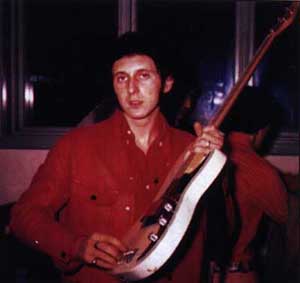
1966 Fender Precision slab bass, from side.
- John owned (and trashed) three of 20 total made by Fender, which were made specifically for the UK market.
- Slab (squared off) body, split pickup, maple neck, black scratch plate.
- Finish is called “White Blonde” by Fender, and “See-Through Blonde” or “See-Through White” colloquially. John describes it as, “...what looked like blue veins coming through the white paintwork.”
-
From January 2009 Vintage Guitar article: “The Four-String White Whale: Fender/Arbiter’s 1966 Slab-Body Precision Bass”
In the world of the Fender bass, few instruments have engendered more lore or legend than the 1966 slab-body Precision. Long rumored, occasionally sighted, and often misunderstood, this is the great white whale of Fender bass collecting! While at first glance having the appearance of a standard ’66 Precision, the instrument has the crucial difference of the uncontoured Telecaster-style ash body; its neck is built with a laid-on maple fingerboard, a seldom-seen custom-order feature at a time when Fender no longed offered maple necks as a stock appointment. While never cataloged or formally advertised, at least two very small batches of this instrument were to have been made in ’66...
The U.K.-market-only Arbiter-ordered basses have these very specific features; maple-capped neck, blond finished ash body, and black/white laminate pickguard. Otherwise, fittings and hardware were the standard ’66 style. Why this particular combination of features was chosen, and by who exactly, has never been fully explained. Whether the English company dictated the specifications or responded to an existing Fender prototype is unknown.
- John: “There is something different about the sound of these Precisions…I’ve tracked it down to the pickups and tone circuit — the sound is much raunchier and gutsy and has a hint of distortion when the volume is flat out.”
- At least one featured an additional tone or pickup control and toggle switch.
-
From April 1995 Bassist interview
“The slab Precisions were like white, squared-off Telecasters, with a split pickup, a maple neck, black scratch plate and what looked like blue veins coming through the white paintwork. I don’t know what they used on them but those basses had a sound of their own, really raunchy with more of a growl than a regular Precision.”
-
Parts would later be used to comprise Frankenstein.
From January 2009 Vintage Guitar article: “The Four-String White Whale: Fender/Arbiter’s 1966 Slab-Body Precision Bass”
Entwistle took some surviving parts from this martyr and another destroyed Telecaster Bass and mounted the maple-capped neck and pickups on an older sunburst Precision body with a white pickguard. This creation, dubbed “Frankenstein,” became his main studio and stage bass through Tommy and Who’s Next, appearing most famously on Live at Leeds and the Rolling Stones’ Rock ’n’ Roll Circus film. Both in its original and rebuilt form, this bass was played many of the most influential Who recordings of all time, and has been listened to intently by countless bassists over the last 40 years!
Thanks to Calvin “Sandy” Buckles for help with this section.
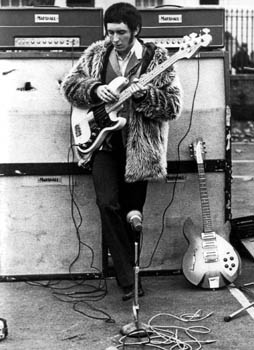
12 Nov., 1966, at Chelsea Barracks, with 1966 Fender Precision slab bass, with two Marshall JTM45 100 100-watt amps and two Marshall 8×12 cabs.
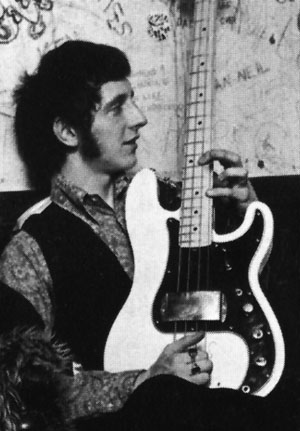
1966 Fender Precision slab bass, closeup of front showing additional control knob and toggle switch.
-
Gibson EB-3 bass:
Introduced in 1961, the EB-3 was the bass guitar equivalent of the Gibson SG, with a slim SG-style body, 30.5″-scale neck, one large humbucker pickup in the neck position and a mini-humbucker in the bridge position; four-way rotary pickup selector switch with volume/tone knobs for each pickup.
- For Substitute recording, 12 Feb. 1966 at Olympic Studios.
John Entwistle:
Pete was always being influenced by other artists. “Substitute” was an attempt to play the introduction from “I Can’t Help Myself” by the Four Tops. He played me the demo of it and I thought it sounded great. We didn’t want it to sound too Motown so I played a Gibson SG medium scale bass with wire-wound strings. When it got to the solo, because we were recording and mixing it virtually live, I thought, yeah, this should be a bass solo, so I turned my volume up and they couldn’t mix me out, so it ended up as a bass solo.
From April 1995 Bassist interview
“On Substitute I played a two pickup medium scale Gibson bass and I managed to find a decent set of Gibson wirewound strings that vibrated properly. The session was going well and I felt that we were ready for the master take, so when it got to the solo in the middle, I turned the bass up and there was nothing the engineer could do about it. They’d previously balanced everything and it was all going through the mixer at the same time.”
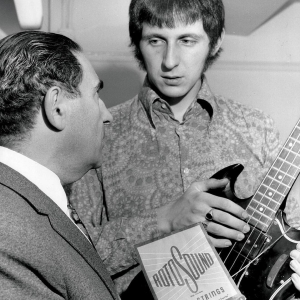
John with sales director Alan Marcuson of Rotosound Strings, and holding a Gibson EB-3 bass.
- For Substitute recording, 12 Feb. 1966 at Olympic Studios.
-
Violin Bass
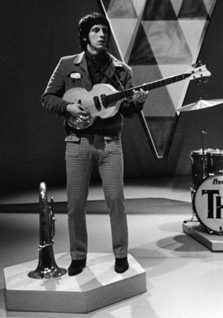
15 June 1966, television appearance with violin bass.
For the television appearance promoting Disguises on 15 June 1966, John used what appears to be an early-60s Höfner natural finish 500/1 violin bass with narrow-spaced toaster pickups, wire tailipece, rectangular control panel, Kluson-style tuning keys. John later notes that he used a Vox violin bass on Magic Bus, recorded 29 May 1968.
“I played that on a Vox violin bass. Absolutely revolting thing that looked like a mint humbug. Vox gave us two guitars each.”
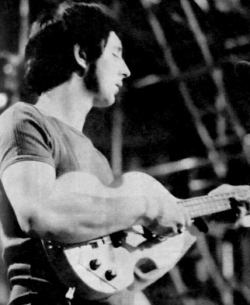
Amplification – 1964–1966
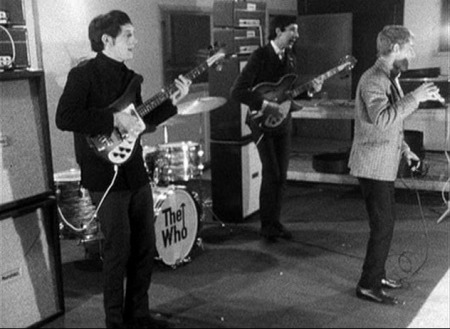
Ca. January 1965, John’s and Pete’s new Marshall 4×12 stacks, each powered by a pair of Marshall JTM45 50-watt amps. John’s bass is Rickenbacker Rose, Morris, Co. LTD., 1999 (4001S) bass.
- Marshall JTM45 50-watt amplifier and the first Marshall 4×12 cabinet.
- Two Vox T.60 solid-state bass amps and cabinets, each with 1×15″ Tannoy speaker for lows, 1×12″ Celestion “Bulldog” for highs.
- Vox AC-100 amplifier heads driving two T.60 cabinets.
In 1964, John first connected his Marshall JTM45 to, first one, then two side-by-side Celestion G12-loaded Marshall 4×12s. Pete followed this up by placing his Marshall 4×12 on a waist-high metal stand, thus generating considerable feedback to the guitar’s pickups. Next, possibly due to the small stages at the time, as well as to create an imposing visual force, Pete stacked one cabinet atop another, driven by his ’64 blonde Fender Bassman 50w head (gold sparkle grille, white round knobs), and thus the “stack” was born.
From late spring/early summer 1965 until November 1965, John Entwistle and Pete Townshend switched to using Vox gear on stage, John with two Vox T.60 amplifiers and cabinets, and Pete with two Vox AC-100 Super DeLuxe 100-watt amplifiers and open-backed cabinets with Midax horns.
The AC-100, the first 100-watt amplifier, used four EL34 valves and was originally designed for John Lennon and George Harrison of the Beatles, who began using them on stage in mid-1964.
The amps, though rated at 100 watts, were not well suited to the Who’s volume, and reliability — with heads catching on fire — was questionable.
I distinctly remember the occasion when Pete first used his VOX A.C.100 on stage. It literally self-destructed during the second number and real ozone started to smoke from the back. Pete nonchalantly disconnected the head and chucked the smoking missile in the direction of the band room and proceeded to set up his old stack while the rest of the band kept playing. In keeping with tradition, the show must go on!
So, unsatisfied with the sound and reliability (and following their van being stolen on 2 Sept. 1965; after which they leased Vox gear until November, when they unceremoniously dumped it back at the hire company), they returned to Marshall, with the debut of the Marshall 8×12 stacks and 100-watt amplifiers in early November 1965.
See Pete’s Marshall Stack and Vox amps sections for more information.
Selected quotes
All quotes and references are copyright their original owners and are included for reference only.
From August 1965, Melody Maker interview
Bass guitarist John is the maniac guitar buyer in the group — he has ten guitars. On HP, they cost an average £150 each. He also owns four bass speaker cabinets, for which he will pay £160 each, and three 100-watt amplifiers which cost £160 each. For various experiments in sound and pop-art, John also has a £150 piano bass, and a £50 piano. He has nearly £3,000 worth of equipment. To add to the expense, John is a stickler for having strings in good condition on all his guitars and gets through about eight sets a month at £4 a set.
Guitar Player, November 1975, interview with John Entwistle
When we first started calling ourselves the Who I used a Marshall 50 watt amp with a 4-12 cabinet. I had the first 4-12 cabinet that Marshall made. We more or less forced them to make 100 watt amps by changing to Vox, who already had one out.
From August 1989 Guitar Player
- How long did it take for your sound concept to begin developing?
Well, I’d learned to play by ear, by playing along with records by Eddie Cochran, Gene Vincent, the Ventures, Buddy Holly, the Shadows, and especially Duane Eddy — his guitar had the sound I wanted my bass to have. When I began experimenting, I still had a sort of thuddy, boomy bass sound, but I remember a turning point a few years later. We had our first hit record with the Who, “I Can’t Explain”, and showed up at a big hall for a concert only to find the place empty because the promoter had forgotten to promote it. So we decided to make use of the situation by having a rehearsal. I had a Rickenbacker bass and Marshall amps at the time, and after we started playing, our manager came up to me and said, “it’s all very well, you playing that fast, but I can’t hear the notes you’re playing in the back. Why don’t you try putting a bit of treble on it?” I’d always been tempted to turn up the treble but didn’t dare, because bassists just didn’t do that. So I opened up the treble on my amp and bass and started playing like Duane Eddy.
That was the turning point, but what I didn’t realize was that I’d set quite a task for myself, because you can’t play sloppily using that much high end. I had to clean it up and find a fluid way of damping the notes so they didn’t blur into each other or vary in volume.
Photo Gallery
Late 1964/early 1965 amplification

Click to view larger version. Ca. August/September 1964, at the Railway Hotel, with Epiphone Rivoli bass, and what appears to be a Marshall amplifier in the backline.

Click to view larger version. Ca. August/September 1964, at the Railway Hotel, with with Rickenbacker Rose, Morris, Co. LTD, 1999 (4001S) bass and Marshall 4×12 speaker cabinet.
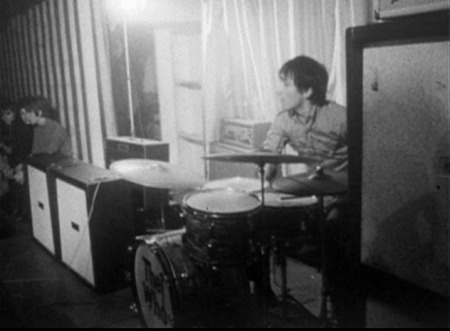
16 Feb. 1965, at the Marquee, view of John’s two Marshall 4×12 cabinets side-by-side, powered by two stacked Marshall JTM45 50-watt amps (though one may be a spare).
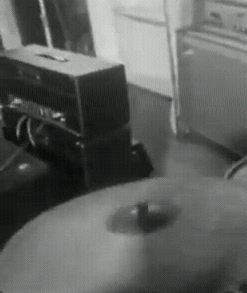
16 Feb. 1965, at the Marquee, closeup view of John’s two stacked Marshall JTM45 50-watt amps (though one may be a spare), on a chair behind two Marshal 4×12 cabinets side by side.
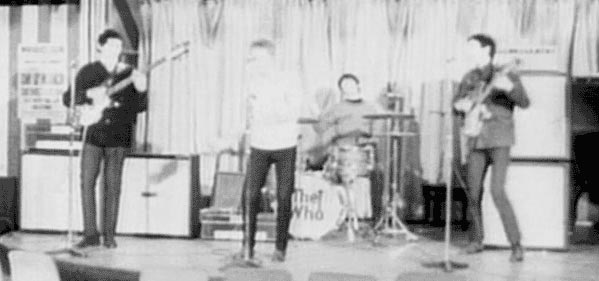
Ca. March 1965, at the Marquee, John playing Rickenbacker Rose, Morris, Co. LTD., 1999 (4001S) bass, and two Marshall 4×12 cabinets side-by-side, powered by Marshall JTM45 50-watt amp.

Ca. 1965, Rickenbacker Rose, Morris, Co. LTD., 1999 (4001S) bass in FireGlo, with two side-by-side Marshall 4×12 cabinets. In a precursor to the actual “Marshall” stack, Pete stacks a blonde ’64 Fender Bassman head on two Marshall 4×12 cabinets with British flag “grillecloths.”
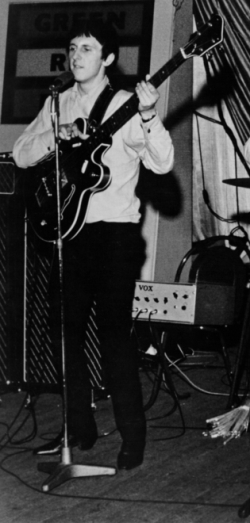
Ca. 1965, with Gretsch 6070 Hollow Body bass and Vox T.60 cabinets topped with Vox AC-100 amplifier heads. Vox PA on chair.
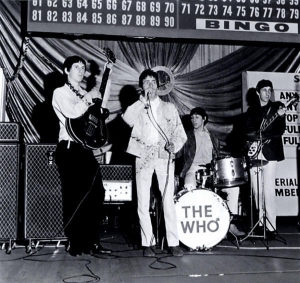
Click to view larger version Ca. 1965, with Gretsch 6070 Hollow Body bass and Vox T.60 cabinets topped with Vox AC-100 amplifier heads. Vox PA on chair.

6 Aug. 1965, front view of Danelectro Long Horn model 4423 bass, and four Vox T.60 cabinets topped with two Vox AC-100 amplifier heads.
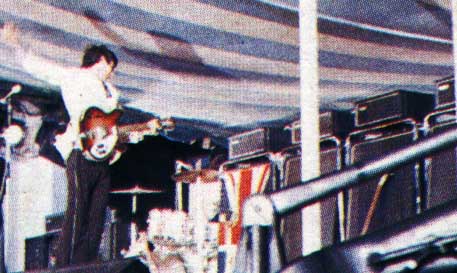
6 Aug. 1965, Vox T.60 cabinets topped with Vox AC-100 amplifier heads visible at far side of stage, with Pete’s row of four Vox AC-100s at stage left.
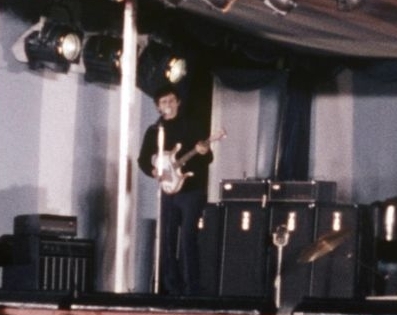
6 Aug. 1965, John’s four Vox T.60 cabinets topped with two Vox AC-100 amplifier heads. Bass is Danelectro Long Horn model 4423 bass.
Late 1965 amplification

26 Jan. 1966, Locarno Ballroom, Stevenage, with John and Pete both playing through two Marshall JTM45 100 (prototype 1959 JTM100 Super Lead; Pete using JTM45 100 Tremolo) 100-watt amplifiers, connected by Y-cable, and driving two Marshall 8×12 cabinets. John’s bass is 1962 Fender Precision Bass.
The advent of the 100-watt Marshall amplifier. John and Pete request Marshall build a 100-watt amp to be heard above the drummer’s din.
- Two Marshall JTM45 100-watt amps
- (see Pete’s Marshall Stack section for more information).
- Two Marshall 8×12 cabinets
Following the leasing of the Vox gear until November, when they unceremoniously dumped it back at the hire company, they returned to Marshall for their continuing quest for volume and power.
Pete urged Marshall to develop an actual “stack,” an 8×12 cabinet. Delivered in November 1965 (first known use is 13 Nov., 1965, at La Locomotive Club, Paris, France), the 8×12s would pair up with the 100w amplifiers to create an imposing backline. The 8×12s featured an angled top portion and a straight profile for the remaining six speakers. These cabinets actually had an open back to the top portion, closed on the bottom. For the most part, these cabinets had all the features of today’s “stack,” but proved unwieldy with their weight and size. Marshall only made six of these 8×12s, four going to The Who and two to the Small Faces. Two weeks later, Pete returned to Jim Marshall asking for the stacks to be cut in half. Although Marshall indicates they couldn’t be divided because of butt joints, as seen in photos, at least some of the cabinets were cut in half to increase portability — as well as make knocking the top cabinet over easier during the destruction finale.
In late 1965, production versions of this “stack” followed in the Marshall 1960A (angled-front top 4×12 cabinet) and 1960B (base; flat-front 4×12 cabinet), the instantly recognizable Marshall “stack” of today.
Through 1966–67, Both Pete and John varied their setups, either in traditional stack form, with the amp on top of the cabinets, two amps stacked high, one on top of the other, on top of cabinets, or as a precursor to their future rigs, with the amps on a stand or chair next to the speaker cabinets. Pete early on ran the guitar to a split “Y” cable to power both amplifiers. Later, he used “daisy chain” cabling, where the guitar lead went into the “High Treble” input of channel I amp and out of channel II into the second amp. John would also use a split cable, or occasionally had dual/stereo jacks on his Jazz bass, with each lead going into one amp, one for treble frequencies (treble dimed, bass rolled off), one for bass frequencies (vice versa).
Pete and John used these pre-production 100-watt amplifiers and the 8×12s, as well as other Marshall amps, such as the production JTM100s and beginning late 1966, model 1967 Marshall Major Lead (affectionately called the “Pig”) 200w amps, and 1982 and 1960 Marshall 4×12 cabinets, into 1967.
From October 1994, Guitar World interview
- GW: You introduced the first Marshall 4×12 cabinet into the Who.
Entwistle: Yeah, but I didn’t buy the very first one. It was a guy in a band called the Flintstones who got that. I bought the second one...and the fourth, and the seventh, and the eight. Pete bought the ones in between. It was great. I’d buy one, he’d buy one, I’d buy one, then he’d buy another. And I went, “is it loud enough? Fuck, I’ll buy two more.” And I started using the two-amp system — bi-amping. Then we had a period where we switched to Vox equipment because we figured it would be louder. But it wasn’t. It just blew up. So we’d always been trying to convince Marshall to make us a 100-watt amp. They told us it would be impossible: the amp would be too heavy to carry around. We said, “Put a handle on each end.”
From Guitar Player, November 1975, interview with John Entwistle
- What type of amplifier and guitar were you using when the Who first formed?
When we first started calling ourselves the Who I used a Marshall 50 watt amp with a 4-12 cabinet. I had the first 4-12 cabinet that Marshall made. We more or less forced them to make 100 watt amps by changing to Vox, who already had one out. Marshall decided that if they were going to keep us, they’d have to make a 100 watt amp. They used to make their amps with speaker material on the front, and they looked completely different. I said, “I don’t like that; I want it all black,” so they changed them. I bought another 4-12 cabinet, and then Pete bought another 4-12 cabinet, and it went on and on and on. We had more equipment than any band in the country — it was ridiculous. I was using a Fender Precision on the first albums, and then I had an Epiphone and a Rickenbacker. Then I got rid of the Precision and got a Gretsch bass, which I could hardly play. I played it for ten minutes, and my hand got worn out. Then I had three Dan Electros in a row because you couldn’t buy the strings small enough to vibrate properly. I only used the guitar until one of the original strings busted, and then I bought another one.
- Why were you going through all those different basses?
I was trying to find something I could play. I felt comfortable with the Rickenbacker, but the neck warped, and it started sounding very strange, so I changed to a [Fender] Jazz Bass. The first proper bass setup I ever used, I had a big cabinet with curtain material on the front, and we used to carry our own equipment then, hire a van to take us to the concert. Because we thought it was too heavy, we used hang the 18″ speaker on a nail every time we’d go to a concert, and when I played a bottom E, it would fall off the nail. So we’d have to stop halfway through the number and hang it back on the nail. The first time I could ever play my E string was after I’d been playing bass for about three years. I’d never actually touched the E string; I was just playing on the first three strings. And the first time I actually touched the E string was when I got my first 4-12 cabinet, and I was using an Epiphone semi-acoustic bass.
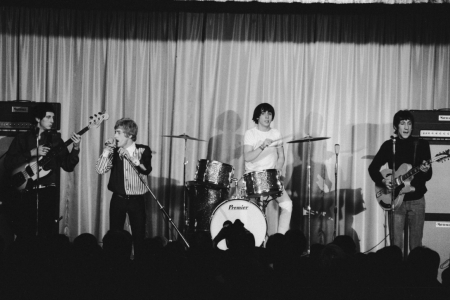
13 Nov. 1965, at La Locomotive Club, Paris, the first known photographed use of the new Marshall 8×12 cabinets. John is using two 1959 JTM100 Super Lead 100-watt amplifiers driving two Marshall 8×12 cabinets; Pete appears to be playing through two Marshall JTM45 100 Tremolo (prototype 1959T JTM100 Super Lead) 100-watt amplifiers driving two Marshall 8×12 cabinets.
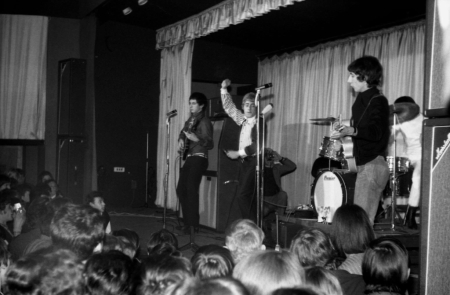
Click to view larger version 13 Nov. 1965, at La Locomotive Club, Paris, the first known photographed use of the new Marshall 8×12 cabinets. John is using two 1959 JTM100 Super Lead 100-watt amplifiers driving two Marshall 8×12 cabinets; Pete appears to be playing through two Marshall JTM45 100 Tremolo (prototype 1959T JTM100 Super Lead) 100-watt amplifiers driving two Marshall 8×12 cabinets. Two Marshall 4×12 model 1969 PA columns stacked at each side of the stage, and a Marshall 1968 JTM100 100-watt Super P.A. amplifier in front of the drum riser.
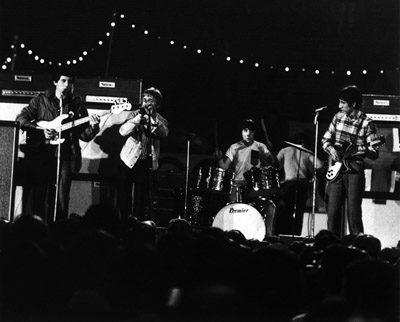
19 Nov. 1965, at the Glad Rag Ball, Wembley. Pete appears to be both playing through a (likely two) Marshall JTM45 100 Tremolo (prototype 1959T JTM100 Super Lead) 100-watt amplifier driving a Marshall 8×12 cabinet adorned with the Union Jack. John is using 1959 JTM100 Super Lead. (Marshall 1969 PA 4×12 cab visible at far left.)
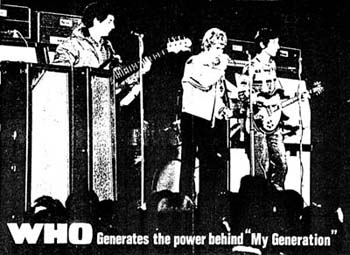
Marshall advert, with the Marshall 8×12 stacks in the backline and two Marshall 4×12 model 1969 PA columns at left, courtesy Max the Mod (offline).

On stage, 2 June 1966, Grona Lund, Sweden, with 1965 Fender Jazz bass and Marshall 1959 JTM100 Super Lead with 8×12 stacks.
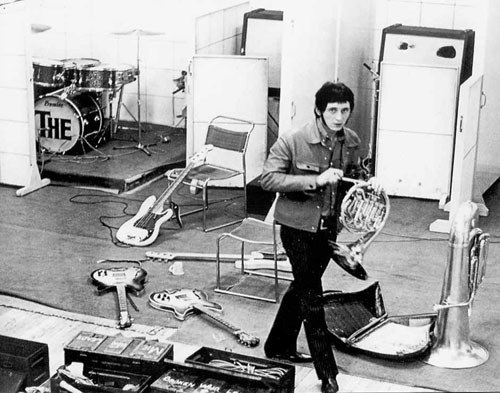
3 Oct. 1966, at CBS studios, London, John holding French horn. Leaning against the chair, the 1962 Fender Precision Bass, left, and on the floor, the 1966 “Slab” Fender Precision Bass. In background, two Marshall 8×12 cabinets for the guitar and bass.

12 Nov., 1966, at Chelsea Barracks, with 1966 Fender Precision slab bass, with two Marshall JTM45 100 100-watt amps and two Marshall 8×12 cabs.
Resources and Information
Contributors
Thanks to those who have made this page possible:
- Paul Winkler (pw_lists@slinkp.com)
- Brad Rodgers (whocollection.com)
- Max The Mod: westminsterinc.com/who1965/equip.htm (offline).
- Calvin “Sandy” Buckles
Additional Information:
- Brad Rodgers at whocollection.com
- Rock Stars Guitars, rockstarsguitars.com
- Sotheby’s May 2003 auction: sothebys.com
- Björn Eriksson’s Rickenbacker Info: rickbeat.com
- Vintage Guitars Info (Rickenbacker): guitarhq.com/rick.html
- Vintage Guitars Info (Gibson): guitarhq.com/gibson9.html
- Vintage Guitars Info (Epiphone): guitarhq.com/epiphone.html
- Vintage Guitars Info (Danelectro): guitarhq.com/dano.html
- Vintage Guitars Info (Fender Bass): guitarhq.com/fender2.html#pbass
- Max The Mod: westminsterinc.com/who1965/equip.htm (offline)
- Rickenbacker Registration: rickresource.com
- alt.guitar.rickenbacker FAQ: faqs.org/faqs/music/guitars/rickenbacker/
- Dr. Tube’s Schematics: drtube.com/guitamp.htm
- PlexiPalace Vintage Amps Forum: vintageamps.com/plexiboard/viewforum.php?f=24 (archived)
- The Vox Showroom: voxshowroom.com
- The Vox Museum: voxamps.com/museum/acroom/
- Bass Culture, by John Entwistle; forewords by Roger Daltrey and Rick Nielsen. Published 2004 by Sanctuary Publishing
Manufacturer’s Links:
- Rickenbacker: rickenbacker.com
- Fender: fender.com
- Marshall Amplification: marshallamps.com
- Sunn Amplification: sunnamps.com
- Epiphone: epiphone.com
- Gibson USA: gibson.com
- Rotosound Strings: rotosound.com
- The Vox Showroom: voxshowroom.com
